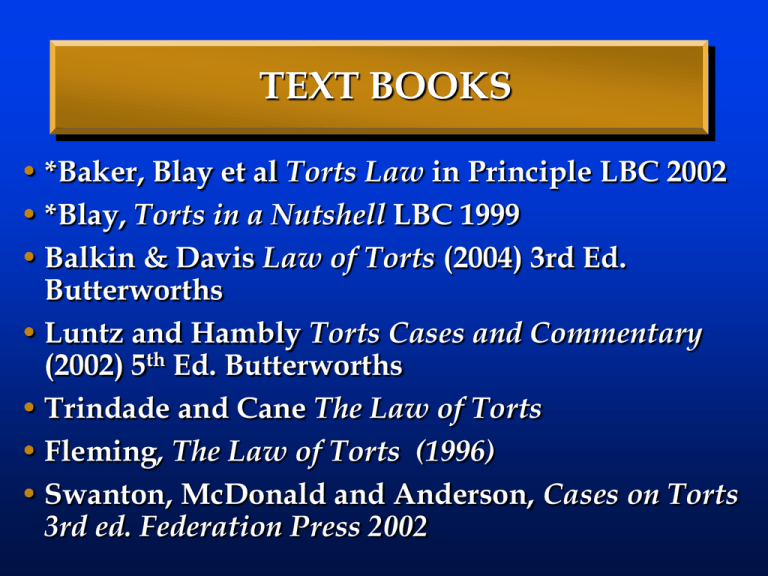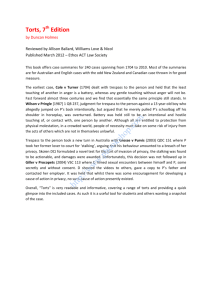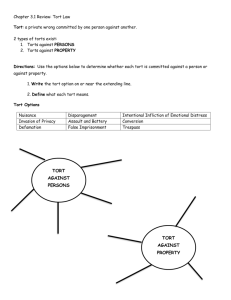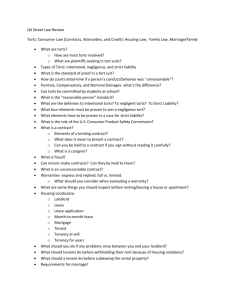TEXT BOOKS
advertisement

TEXT BOOKS • *Baker, Blay et al Torts Law in Principle LBC 2002 • *Blay, Torts in a Nutshell LBC 1999 • Balkin & Davis Law of Torts (2004) 3rd Ed. Butterworths • Luntz and Hambly Torts Cases and Commentary (2002) 5th Ed. Butterworths • Trindade and Cane The Law of Torts • Fleming, The Law of Torts (1996) • Swanton, McDonald and Anderson, Cases on Torts 3rd ed. Federation Press 2002 LEC Torts Website • http://www.usyd.edu.au/lec/subjects/torts/ materials.htm WHAT IS A TORT? •A tort is a civil wrong •That (wrong) is based a breach of a duty imposed by law •Which (breach) gives rise to a (personal) civil right of action for for a remedy not exclusive to another area of law THE DIFFERENCE BETWEEN A TORT AND A CRIME •A crime is public /community wrong that gives rise to sanctions usually designated in a specified code. A tort is a civil ‘private’ wrong. •Action in criminal law is usually brought by the state or the Crown. Tort actions are usually brought by the victims of the tort. • The principal objective in criminal law is punishment. In torts, it is compensation THE DIFFERENCE BETWEEN A TORT AND A CRIME • Differences in Procedure: – Standard of Proof Criminal law: beyond reasonable doubt »Torts: on the balance of probabilities » SIMILARITIES BETWEEN TORTS AND CRIME •They both arise from wrongs imposed by law •Certain crimes are also actionable torts; eg trespass: assault •In some cases the damages in torts may be punitive •In some instances criminal law may award compensation under criminal injuries compensation legislation. TORTS DISTINGUISHED FROM BREACH OF CONTRACT •A breach of contract arises from promises made by the parties themselves. •In contract, the amount of damages is usually liquidated or predetermined. Torts damages are usually unliquidated SIMILARITIES BETWEEN TORT AND CONTRACT •Both tort and breach of contract give rise to civil suits •In some instances, a breach of contract may also be a tort: eg an employer’s failure to provide safe working conditions THE AIMS OF TORT LAW •Loss distribution/adjustment: shifting losses from victims to perpetrators •Compensation: Through the award of (pecuniary) damages –The object of compensation is to place the victim in the position he/she was before the tort was committed. •Punishment: through exemplary or punitive damages. This is a secondary aim. INTERESTS PROTECTED IN TORT LAW • Personal security – Trespass – Negligence • Reputation – Defamation • Property – Trespass – Conversion • Economic and financial interests LIABILITY IN TORT LAW • Liability = responsibility • Liability may be based on fault or it may be strict • Fault liability: the failure to live up to a standard through an act or omission . – Venning v Chin – Platt v Nutt • Types of fault liability: FAULT LIABILITY NEGLIGENCE INTENTION Intention in Torts •Deliberate or wilful conduct •‘Constructive’ intent: where the consequences of an act are substantially certain: the consequences are intended •Where conduct is reckless •Transferred intent: where D intends to hit ‘B’ but misses and hits ‘P’ Negligence in Torts •When D is careless in his/her conduct •When D fails to take reasonable care to avoid a reasonably foreseeable injury to another. STRICT LIABILITY •No fault is required for strict liability ACTIONS IN TORT LAW • Trespass –Direct injuries –Requires no proof of damage •Action on the Case/Negligence –Indirect injuries –Requires proof of damage INTENTIONAL TORTS • INTENATIONAL TORTS Trespass Conversion Detinue WHAT IS TRESPASS? • Intentional or negligent act of D which directly causes an injury to the P or his /her property without lawful justification •The Elements of Trespass: – fault: intentional or negligent act – injury* must be direct – injury* may be to the P or to his/her property – No lawful justification *INJURY IN TRESPASS • Injury = a breach of right, not necessarily actual damage • Trespass requires only proof of injury not actual damage THE GENERAL ELEMENTS OF TRESPASS Intentional/ negligent act + Direct interference with person or property + Absence of lawful justification + “x” element = A specific form of trespass SPECIFIC FORMS OF TRESPASS TRESPASS PERSON BATTERY ASSAULT FALSE IMPRISONMENT PROPERTY BATTERY • The intentional or negligent act of D which directly causes a physical interference with the body of P without lawful justification •The distinguishing element: physical interference with P’s body THE INTENTIONAL ACT IN BATTERY • No liability without intention • The intentional act = basic willful act + the consequences. CAPACITY TO FORM THE INTENT • D is deemed capable of forming intent if he/she understands the nature of (‘intended’) his/her act • -Infants – Lunatics – Morriss v Marsden [1952] – Hart v A. G. of Tasmania ( infant cutting another infant with razor blade) THE ACT MUST CAUSE PHYSICAL INTERFERENCE • The essence of the tort is the protection of the person of P. D’s act short of physical contact is therefore not a battery •The least touching of another could be battery – Cole v Turner (dicta per Holt CJ) •‘The fundamental principle, plain and incontestable, is that every person’s body is inviolate’ ( per Goff LJ, Collins v Wilcock) The Nature of the Physical Interference •Rixon v Star City Casino (D places hand on P’s shoulder to attract his attention; no battery) • Collins v Wilcock (Police officer holds D’s arm with a view to restraining her when D declines to answer questions and begins to walk away; battery) – Platt v Nutt SHOULD THE PHYSICAL INTERFERENCE BE HOSTILE? •Hostility may establish a presumption of battery; but •Hostility is not material to proving battery –Wilson v Pringle ( The ration in this case is questionable) •The issue may revolve on how one defines ‘hostility’ THE INJURY MUST BE CAUSED DIRECTLY • Injury should be the immediate Case Law: The – Scott v Shepherd (Lit squib/fireworks in market place) – Hutchins v Maughan (poisoned bait left for dog) – Southport v Esso Petroleum(Spilt oil on P’s beach) THE ACT MUST BE WITHOUT LAWFUL JUSTIFICATION • Consent is Lawful justification • Consent must be freely given by the P if P is able to understand the nature of the act – Allen v New Mount Sinai Hospital • Lawful justification includes the lawful act of law enforcement officers – Wilson v. Marshall (D accused of assaulting police officer, held officer’s conduct not lawful) TRESPASS:ASSAULT • The intentional/negligent act or threat of D which directly places P in reasonable apprehension of an imminent physical interference with his or her person or of someone under his or her control THE ELEMENTS OF ASSAULT • There must be a direct threat: – Hall v Fonceca (Threat by P who shook hand in front of D’s face in an argument) – Rozsa v Samuels ( threat to cut P into bits) • In general, mere words are not actionable – Barton v Armstrong • In general, conditional threats are not actionable – Tuberville v Savage – Police v Greaves – Rozsa v Samuels THE ELEMENTS OF ASSAULT • The apprehension must be reasonable; the test is objective • The interference must be imminent Police v Greaves – Rozsa v Samuels – Barton v Armstrong – Hall v Fonceca – Zanker v Vartzokas (P jumps out of a moving van to escape from D’s unwanted lift) THE GENERAL ELEMENTS OF TRESPASS Intentional/ negligent act + Direct interference + Absence of lawful justification + “x” element = A specific form of trespass SPECIFIC FORMS OF TRESPASS TRESPASS PERSON BATTERY ASSAULT FALSE IMPRISONMENT PROPERTY FALSE IMPRISONMENT • The intentional or negligent act of D which directly causes the total restraint of P and thereby confines him/her to a delimited area without lawful justification • The essential distinctive element is the total restraint THE ELEMENTS OF THE TORT •It requires all the basic elements of trespass: – Intentional/negligent act – Directness – absence of lawful justification/consent , and • total restraint RESTRAINT IN FALSE IMPRISONMENT • The restraint must be total – Bird v Jones (passage over bridge) – The Balmain New Ferry Co v Robertson • Total restraint implies the absence of a reasonable means of escape – Burton v Davies (D refuses to allow P out of car) • Restraint may be total where D subjects P to his/her authority with no option to leave – Symes v Mahon (police officer arrests P by mistake) – Myer Stores v Soo FORMS OF FALSE IMPRISONMENT • See the following Cases: – Cowell v. Corrective Services Commissioner of NSW (1988) Aust. Torts Reporter ¶81-197. – Louis v. The Commonwealth of Australia 87 FLR 277. – Lippl v. Haines & Another (1989) Aust. Torts Reporter ¶80-302; (1989) 18 NSWLR 620. – Dickenson Waters VOLUNTARY CASES • In general, there is no FI where one voluntarily submits to a form of restraint – Herd v Werdale (D refuses to allow P out of mine shaft) – Robison v The Balmain New Ferry Co. (D refuses to allow P to leave unless P pays fare) – Lippl v Haines • Where there is no volition for restraint, the confinement may be FI (Bahner v Marwest Hotels Co.) WORDS AND FALSE IMPRISONMENT •In general, words can constitute FI KNOWLEDGE IN FALSE IMPRISONMENT •The knowledge of the P at the moment of restraint is not essential. – Merring v Graham White Aviation – Murray v Ministry of Defense




